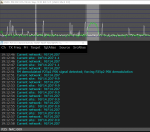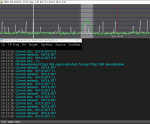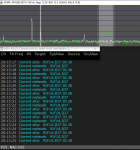We kinda saw we would be out of luck on true TDMA P25 with OpenSKY.. It was TDMA from the ground up, only it was 4 slot, not just 2. (Which is the next progression once they actually DO get it right.)
You are using an out of date browser. It may not display this or other websites correctly.
You should upgrade or use an alternative browser.
You should upgrade or use an alternative browser.
Duke Energy P25 System
- Thread starter AESFTW
- Start date
From what I've heard, OpenSky had some terrible audio quality for the users. I'm not fully sure how true that is though.
To clarify, the P25 spec for TDMA control channels does indeed allow for control channel signaling on both slots, if desired. Or you can have the control channel signaling on one slot with traffic on the second slot.
If dual control channel signaling is implemented, it effectively doubles the rate of signaling, allowing for the current limit of simultaneous calls to be greatly increased (currently limited by the 40 message per second FDMA control channel for implicit systems).
The TDMA control channel is a steady stream of data, not "bursts". It's no different from the traditional FDMA control channel other than 2-slot TDMA in play.
If dual control channel signaling is implemented, it effectively doubles the rate of signaling, allowing for the current limit of simultaneous calls to be greatly increased (currently limited by the 40 message per second FDMA control channel for implicit systems).
The TDMA control channel is a steady stream of data, not "bursts". It's no different from the traditional FDMA control channel other than 2-slot TDMA in play.
The only reason the original flavor of OpenSky is 4-slot TDMA is because the signal occupies a 25 kHz wide channel. If you doubled the channel width of P25, you could also effectively go from 2-slot TDMA to 4-slot TDMA. That's not going to happen due to the restrictions on channel width in most bands, in particular VHF and UHF requiring 12.5 kHz narrowband channels. OpenSky 2 is 2-slot TDMA using 12.5 kHz channels, not unlike P25 TDMA.We kinda saw we would be out of luck on true TDMA P25 with OpenSKY.. It was TDMA from the ground up, only it was 4 slot, not just 2. (Which is the next progression once they actually DO get it right.)
Interesting. Also interesting is the fact that the P25 standard didn't have to play by the same rules as everyone else. Sure there might be two 6.25 kHz channels active on a single TDMA channel, but it isn't guaranteed. A slight bending of the intended rules, but I'm convinced that would not have ever happened for a small business endeavor. Regarding your earlier posts on 2-channel CC, I haven't been able to obtain the latest specs, so I can't confirm on what you said about it. It certainly seems plausible, so I assume you are correct. Thanks for the correction.The only reason the original flavor of OpenSky is 4-slot TDMA is because the signal occupies a 25 kHz wide channel. If you doubled the channel width of P25, you could also effectively go from 2-slot TDMA to 4-slot TDMA. That's not going to happen due to the restrictions on channel width in most bands, in particular VHF and UHF requiring 12.5 kHz narrowband channels. OpenSky 2 is 2-slot TDMA using 12.5 kHz channels, not unlike P25 TDMA.
P25 TDMA is two alternating slots within a 12.5 kHz wide channel, not two side-by-side 6.25 kHz channels. That makes it 6.25 kHz equivalent, which was supposed to be the next step in ultra-narrowbanding the 700 MHz spectrum, however that was nixed some time ago and it remains 12.5 kHz. Therefore there is no issue with a 12.5 kHz TDMA channel having only one slot active, as 6.25 kHz efficiency is not mandated.Interesting. Also interesting is the fact that the P25 standard didn't have to play by the same rules as everyone else. Sure there might be two 6.25 kHz channels active on a single TDMA channel, but it isn't guaranteed. A slight bending of the intended rules, but I'm convinced that would not have ever happened for a small business endeavor.
There is plenty of info out there from official sources, you don't have to take my word for it (although you probably should).Regarding your earlier posts on 2-channel CC, I haven't been able to obtain the latest specs, so I can't confirm on what you said about it. It certainly seems plausible, so I assume you are correct. Thanks for the correction.
-RRI-RRMediaGroup.png)
New Standard for P25 TDMA Control Channel Approved for Ballot
MissionCritical Communications, Radio Resource International, and Public Safety Report - wireless voice and data communications for mobile, remote and public safety operations
Attachments
I've been through the process many times. I'm saying I don't think that argument would have ever worked for me : ) Yes, you are correct. That is what they determined.P25 TDMA is two alternating slots within a 12.5 kHz wide channel, not two side-by-side 6.25 kHz channels. That makes it 6.25 kHz equivalent,
Thanks for all the links! I will check them out.
CanesFan95
Analog already is interoperable.
These systems have gotten awfully over-complicated. Can you imagine a radio getting one little 'chip' of RF static and missing a digital packet on the control channel and then getting all screwed up. Like, you remember in the analog days when you moved a portable around or the anetnna blew in the wind and you would get static or picketfencing that would fade in and out? So now we have these overly fangled digital systems with these intricate digital formats/commands which you can't rely on because what if you get an occasional blip of static that messes up the data?
That's why the messages are repeated multiple times per second. Do you honestly think that was never taken into consideration? 🤦♂️These systems have gotten awfully over-complicated. Can you imagine a radio getting one little 'chip' of RF static and missing a digital packet on the control channel and then getting all screwed up.
- Joined
- Nov 16, 2004
- Messages
- 2,091
Information collected so far from the greater Cincinnati, Ohio area.
** = Confirmed site
? = Site not confirmed
?? = Site not confirmed but highly likely
Site Name: Alexandria Cooper, Campbell County, Kentucky ?
Call Sign: WRJM735
WACN: 91F14
System ID: 201
RFSS: 2
Site ID: 2
NAC: 002
8-768 - 855.8125 - CC
Neighbors
52.52 - CC= 8-936 - 856.8625 - Ryland Heights
57.57 - CC= 8-584 - 854.6625 - Verona
63.63 - CC= 8-544 - 854.4125 - Zimmer Hill
----------
Site Name: Brecon Radio, Hamilton County, Ohio **
Call Sign: WRJK869, WRJM686
WACN: 91F14
System ID: 201
RFSS: 10
Site ID: 10
NAC: 00A
8-1288 - 859.0625 - CC
8-1360 - 859.5125 - SCC
8-1584 - 860.9125 - SCC
Neighbors
No neighbors list reported
----------
Site Name: Dana, Hamilton County, Ohio **
Call Sign: WRJM686
WACN: 91F14
System ID: 201
RFSS: 22
Site ID: 22
NAC: 016
8-924 - 856.7875 - CC
8-1092 - 857.8375 - SCC
8-1336 - 859.3625 - SCC
Neighbors
No neighbors list reported
----------
Site Name: Dunlap, Hamilton County, Ohio **
Call Sign: WRJK869
WACN: 91F14
System ID: 201
RFSS: 26
Site ID: 26
NAC: 01A
8-704 - 855.4125 - CC
8-1052 - 857.5875 - SCC
8-1372 - 859.5875 - SCC
Neighbors
10.10 - CC= 8-1288 - 859.0625 - Brecon Radio
24.24 - CC= 8.648 - 855.0625 - ?
40.40 - CC= 8-884 - 856.5375 - Lawrenceburg
69.69 - CC= 8-600 - 854.7625 - ?
----------
Site Name: Lawrenceburg, Dearborn County, Indiana ?
Call Sign: WRJK869
WACN: 91F14
System ID: 201
RFSS: 40
Site ID: 40
NAC: 028
8-884 - 856.5375 - CC
Neighbors
7.7 - CC= 8-1340 - 859.3875 - ?
26.26 - CC= 8-704 - 855.4125 - Dunlap
30.30 - CC= 8-896 - 856.6125 - ?
61.61 - CC= 8-644 - 855.0375 - Wilmington Substation
69.69 - CC= 8-600 - 854.7625 - ?
----------
Site Name: Ryland Heights, Kenton County, Kentucky ?
Call Sign: WRKI239
WACN: 91F14
System ID: 201
RFSS: 52
Site ID: 52
NAC: 034
8-936 - 856.8625 - CC
Neighbors
1.1 - CC= 8-544 - 854.4125 - ?
2.2 - CC= 8-768 - 855.8125 - Alexandria Cooper
22.22 - CC= 8-924 - 856.7875 - Dana
57.57 - CC= 8-584 - 854.6625 - Verona
63.63 - CC= 8-544 - 854.4125 - Zimmer Hill
----------
Site Name: Verona, Boone County, Kentucky ??
Call Sign: WRJM686
WACN: 91F14
System ID: 201
RFSS: 57
Site ID: 57
NAC: 039
8-584 - 854.6625 - CC
8-772 - 855.8375 - SCC
8-1180 - 858.3875 - SCC
Neighbors
No neighbors list reported
----------
Site Name: Wilmington Substation, Dearborn County, Indiana ?
Call Sign: WRJM302
WACN: 91F14
System ID: 201
RFSS: 61
Site ID: 61
NAC: 03D
8-644 - 855.0375 - CC
Neighbors
7.7 - CC= 8-1340 - 859.3875 - ?
40.40 - CC= 8-884 - 856.5375 - Lawrenceburg
58.58 - CC= 8-1412 - 859.8375 - ?
----------
Site Name: Zimmer Hill, Clermont County, Ohio ??
Call Sign: WRKI239
WACN: 91F14
System ID: 201
RFSS: 63
Site ID: 63
NAC: 03F
8-544 - 854.4125 - CC
8-896 - 856.6125 - SCC
8-1212 - 858.5875 - SCC
Neighbors
No neighbors list reported
----------
** = Confirmed site
? = Site not confirmed
?? = Site not confirmed but highly likely
Site Name: Alexandria Cooper, Campbell County, Kentucky ?
Call Sign: WRJM735
WACN: 91F14
System ID: 201
RFSS: 2
Site ID: 2
NAC: 002
8-768 - 855.8125 - CC
Neighbors
52.52 - CC= 8-936 - 856.8625 - Ryland Heights
57.57 - CC= 8-584 - 854.6625 - Verona
63.63 - CC= 8-544 - 854.4125 - Zimmer Hill
----------
Site Name: Brecon Radio, Hamilton County, Ohio **
Call Sign: WRJK869, WRJM686
WACN: 91F14
System ID: 201
RFSS: 10
Site ID: 10
NAC: 00A
8-1288 - 859.0625 - CC
8-1360 - 859.5125 - SCC
8-1584 - 860.9125 - SCC
Neighbors
No neighbors list reported
----------
Site Name: Dana, Hamilton County, Ohio **
Call Sign: WRJM686
WACN: 91F14
System ID: 201
RFSS: 22
Site ID: 22
NAC: 016
8-924 - 856.7875 - CC
8-1092 - 857.8375 - SCC
8-1336 - 859.3625 - SCC
Neighbors
No neighbors list reported
----------
Site Name: Dunlap, Hamilton County, Ohio **
Call Sign: WRJK869
WACN: 91F14
System ID: 201
RFSS: 26
Site ID: 26
NAC: 01A
8-704 - 855.4125 - CC
8-1052 - 857.5875 - SCC
8-1372 - 859.5875 - SCC
Neighbors
10.10 - CC= 8-1288 - 859.0625 - Brecon Radio
24.24 - CC= 8.648 - 855.0625 - ?
40.40 - CC= 8-884 - 856.5375 - Lawrenceburg
69.69 - CC= 8-600 - 854.7625 - ?
----------
Site Name: Lawrenceburg, Dearborn County, Indiana ?
Call Sign: WRJK869
WACN: 91F14
System ID: 201
RFSS: 40
Site ID: 40
NAC: 028
8-884 - 856.5375 - CC
Neighbors
7.7 - CC= 8-1340 - 859.3875 - ?
26.26 - CC= 8-704 - 855.4125 - Dunlap
30.30 - CC= 8-896 - 856.6125 - ?
61.61 - CC= 8-644 - 855.0375 - Wilmington Substation
69.69 - CC= 8-600 - 854.7625 - ?
----------
Site Name: Ryland Heights, Kenton County, Kentucky ?
Call Sign: WRKI239
WACN: 91F14
System ID: 201
RFSS: 52
Site ID: 52
NAC: 034
8-936 - 856.8625 - CC
Neighbors
1.1 - CC= 8-544 - 854.4125 - ?
2.2 - CC= 8-768 - 855.8125 - Alexandria Cooper
22.22 - CC= 8-924 - 856.7875 - Dana
57.57 - CC= 8-584 - 854.6625 - Verona
63.63 - CC= 8-544 - 854.4125 - Zimmer Hill
----------
Site Name: Verona, Boone County, Kentucky ??
Call Sign: WRJM686
WACN: 91F14
System ID: 201
RFSS: 57
Site ID: 57
NAC: 039
8-584 - 854.6625 - CC
8-772 - 855.8375 - SCC
8-1180 - 858.3875 - SCC
Neighbors
No neighbors list reported
----------
Site Name: Wilmington Substation, Dearborn County, Indiana ?
Call Sign: WRJM302
WACN: 91F14
System ID: 201
RFSS: 61
Site ID: 61
NAC: 03D
8-644 - 855.0375 - CC
Neighbors
7.7 - CC= 8-1340 - 859.3875 - ?
40.40 - CC= 8-884 - 856.5375 - Lawrenceburg
58.58 - CC= 8-1412 - 859.8375 - ?
----------
Site Name: Zimmer Hill, Clermont County, Ohio ??
Call Sign: WRKI239
WACN: 91F14
System ID: 201
RFSS: 63
Site ID: 63
NAC: 03F
8-544 - 854.4125 - CC
8-896 - 856.6125 - SCC
8-1212 - 858.5875 - SCC
Neighbors
No neighbors list reported
----------
Information collected so far from the greater Cincinnati, Ohio area.
Very nice. Thank you. What is confirmed will be added to the DB, and that which is not confirmed yet will be added to the wiki (as soon as I get the chance to create the wiki info).
Mike
In my haste creating the Duke Energy Wiki, I botched the AEP wiki. I need to fix that before I continue on with the Duke wiki.
Mike
Mike
On Site 20 sid 2d7 Holopaw 856.8375a 860.3875c 860.9125a appears the alt channels are not listed also sites 40 & 52 missing alt channels. I know when I travel next month I'll look at some counties in NE FL see what I get.
Do you need for me to revert your changes? How far back do you want me to go?
View attachment 107131
Thanks for the offer. It turns out I figured it out. I’ve never had to and do “something beforethanks for the offer. It turns out I figured it out. I’ve never had to “undo “something before in the wiki but I think I got it back to where it needs to be. I’ll look at it once more when I’m back in front of the computer, and if something doesn’t look right I’ll reach out to you.
thanks
mike
CanesFan95
Analog already is interoperable.
New to the thread here and just wanted to re-post something from another thread at the request of the mods. Basically, I found a couple frequencies 854.5125 & 854.6125 WRHY215 & WRJI625 in Pinellas County, FL that both sound like some sorta control channel, but nothing like I've ever heard. They sound like a weak, snowy control channel, but they're strong signals. DSD+ doesn't decode anything. The strange thing is the sound of what's on the frequencies. It doesn't sound the same as any kind of control channel I've ever heard, if it even is a control channel. So I wonder if it's some weird new kind of system.
Went ahead and tried running the new DSD+ Fast Lane version that just came out on these 2 frequencies and now getting a little more info, but no voice calls or other frequencies. The NAC on both frequencies quickly jumps between 001, 009, & FFF back and forth. And the Event Window just keeps scrolling the network and site, but doesn't actually decode anything:


CanesFan95
Analog already is interoperable.
Found another Duke frequency 860.3875 WRHZ715 (Land O' Lakes) & WRJI625 (St. Petersburg) doing the same thing, switching between NACs 01E and FFF:

So:
854.5125 flips rapidly between 009 & FFF
854.6125 flips rapidly between 001 & FFF
860.3875 flips rapidly between 01E & FFF.
DSD+ doesn't populate any frequencies at all on the Channel Activity.

So:
854.5125 flips rapidly between 009 & FFF
854.6125 flips rapidly between 001 & FFF
860.3875 flips rapidly between 01E & FFF.
DSD+ doesn't populate any frequencies at all on the Channel Activity.
reconrider8
Member
Wonder when nc will start testing. As of now they are still on their 900 mhz system
Found another Duke frequency 860.3875 WRHZ715 (Land O' Lakes) & WRJI625 (St. Petersburg) doing the same thing, switching between NACs 01E and FFF:
View attachment 107135
So:
854.5125 flips rapidly between 009 & FFF
854.6125 flips rapidly between 001 & FFF
860.3875 flips rapidly between 01E & FFF.
DSD+ doesn't populate any frequencies at all on the Channel Activity.
this is exactly what i see with site 008.
I've been running all the frequencies that are listed to them on the daily (in Gaston and Mecklenburg) while I'm at work and no luck. Only OpenSky has been active for now.Wonder when nc will start testing. As of now they are still on their 900 mhz system
Similar threads
- Replies
- 36
- Views
- 2K
- Replies
- 8
- Views
- 718
- Replies
- 4
- Views
- 2K

